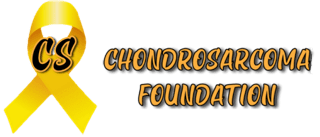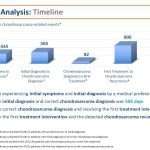How Diagnosis is Critical to Proper Treatment of Chondrosarcoma
Using a different method (Time to Event) to determine the impact Diagnosis / Misdiagnosis has on Care.
The Chondrosarcoma Foundation was the first foundation to be inducted into the NORD IAMRARE Patient Registry 2.0 platform. Since our launch on March 1, 2023, we have had over 230 chondrosarcoma patients participate in the registry, and we are reporting the results of our first full data analysis from the data collected from 169 participants (patients or caregivers) who completed all the surveys in the registry. This is the first global natural history study addressing chondrosarcoma. For the past ten weeks we have been sharing our findings (one result at a time) to help both the sarcoma / oncology medical profession and the chondrosarcoma patient community understand and use these results towards developing better protocols, practices / interventions as well as building better research and clinical trials.
For chondrosarcoma patients, caregivers and families, we want them to be aware of the treatment options as well as the efficacy of these options as reported by participants in the registry. The Patient Registry consists of data collected as self-reports from fellow chondrosarcoma patients and caregivers. We are grateful to all who have shared their stories and those who have chosen to participate in the registry. We encourage patients diagnosed with chondrosarcoma to share their journey and help us create a larger aggravated database of results to help navigate research, clinical trials, and medical practice.
We are learning a lot from our first analysis. We collected the data on chondrosarcoma sub-type, misdiagnosis, recurrence, metastasis, and outcomes of surgery, radiation, traditional chemotherapy, and immunotherapy. We also assessed if chondrosarcoma patients were aware and fully understood their disease, subtype, and prognosis. If you have not seen our earlier posts, we invite you to go to our web site: https://csfshayna.org/cs-foundation-blog/
Introduction: Chondrosarcoma patients face challenges in diagnosing their rare diseases. This often results in delays and misdiagnoses, with potential serious consequences on treatment decisions, prognosis, and survival. While data addressing diagnostic pathways may exist, the chondrosarcoma community lacks a comprehensive effort to assess its impact. The Patient Registry aims to gather valuable information to better understand the patient’s experience on their diagnostic journey.
To further examine diagnostic and treatment pathways and disease course, the Patient Registry conducted a time-to-event analysis for chondrosarcoma patients. This includes their first experience of symptoms, their initial diagnosis, their correct diagnosis (if misdiagnosed), their first treatment intervention and recurrence. The data to construct timelines was done through “date pickers”. The participant in the registry selected the month/day/year for each phase of their journey listed above.
Results: In a previous post on the Chondrosarcoma Registry, we reported that 42.3% of chondrosarcoma patients indicated they were not initially diagnosed with chondrosarcoma (in most cases misdiagnosed). Out of 169 participants, n= 84 (49.7%) reported they were initially diagnosed with chondrosarcoma and n=71 (42.3%) reported they were not initially diagnosed with chondrosarcoma. Listed below are the results of the time-to-event analysis reported in days and highlighted in the attached graphs and tables:
1. The mean time between experiencing initial symptoms and initial diagnosis by a medical professional was 563 days
2. The mean time between initial diagnosis and correct chondrosarcoma diagnosis was 504 days (can conceivably be considered additional time).
3. Conventional and non-conventional patients had similar time from symptom onset to chondrosarcoma diagnosis (450 vs. 443 days)
4. The time from misdiagnosis to correct chondrosarcoma diagnosis was 460 days in conventional chondrosarcoma patients and 181 days in patients with non-conventional chondrosarcoma
5. The mean time between correct chondrosarcoma diagnosis and receiving the first treatment intervention was 82 days
Conclusions: Overall, there may be a lot of reasons for the time lapse between initial symptoms and an initial diagnosis. Our results suggest it took approximately 19 months (563 days) before a chondrosarcoma patient received a diagnosis. It could be that chondrosarcoma tends to grow slowly and symptoms including pain, swelling or a lump do not get to the point where the patient feels they need to seek medical assistance. Our findings also show that in case a patient obtained an initial diagnosis other than chondrosarcoma (in most cases a misdiagnosis), it might take up to 16 more months (504 days) to obtain chondrosarcoma diagnosis.
Interestingly, there were no differences noted between conventional and non-conventional chondrosarcoma when it pertains to time from symptom onset to chondrosarcoma diagnosis (450 vs 443 days). However, our findings indicate disparities if patients were initially misdiagnosed. In patients with conventional chondrosarcoma, it took approximately 15 months (460 days) from misdiagnosis to correct diagnosis, as opposed to non-conventional chondrosarcoma 6 months (181 days).
Our results also indicate that if a patient was not initially diagnosed with chondrosarcoma, it could conceivably take approximately 28 more months (844 days) to diagnose conventional chondrosarcoma and approximately 6.5 months (192 days) to diagnose non-conventional chondrosarcoma.
Finally, our time-to-event analysis indicates the first treatment intervention, typically surgery, occurs within 3 months (82 days) of the proper diagnosis.
Diagnosing chondrosarcoma is difficult. The gold standard for a proper diagnosis is the tissue biopsy evaluated by a pathologist experienced in diagnosing bone and connective tissue cancers. More research and efforts are needed to accurately diagnose chondrosarcoma at the initial evaluation (the right diagnosis the first time) to avoid delays and misdiagnoses and help prevent serious consequences on treatment prognosis and survival.
Your participation is essential.
Be a part of the Chondrosarcoma Patient Registry.
To Register: https://chondrosarcoma.iamrare.org/
It is not too late to sign up to participate in the Chondrosarcoma Patient Registry. The register is open at any time for chondrosarcoma patients or caregivers to go on-line and complete 9 surveys which will take less than an hour to complete. We need you to share your journey and help progress research in chondrosarcoma.
The Chondrosarcoma Patient Registry creates a platform for patients around the world to strengthen their voices and share information about this rare bone cancer. The patient data is treated confidentially, and all data are de-identified for the research purposes.
This global resource will provide data for researchers to use to advance drug development and treatment options and help improve patient care. The patient information that the registry collects will help give direction to scientists on areas in which to focus their research efforts, and to hopefully allow clinicians to see trends in patient responses to treatment for chondrosarcoma. The hope for the future is to illuminate treatments that have had some success that may become the standard of care for this ultra-rare bone cancer.


